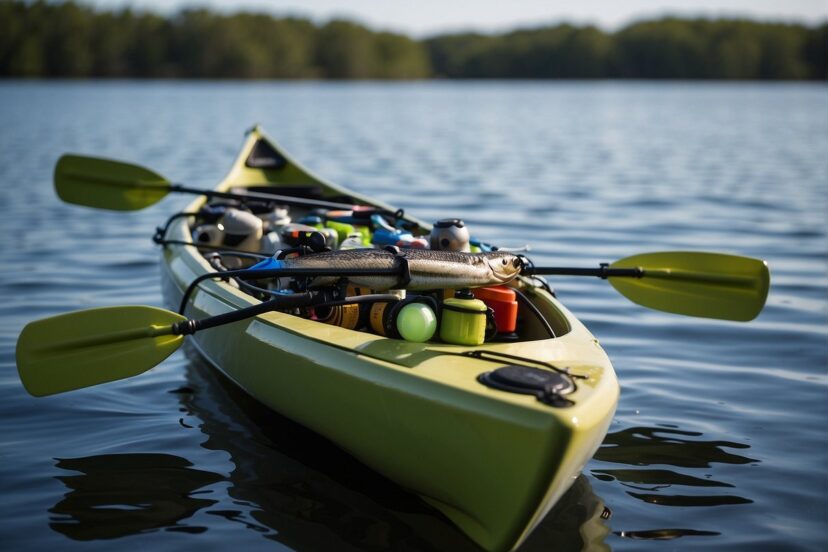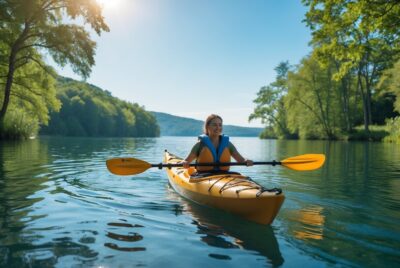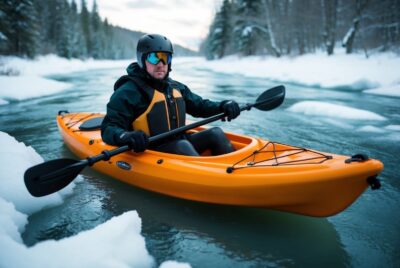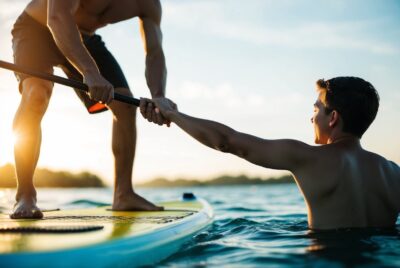Kayak Catfishing Essentials: Gear, Techniques, and Hotspots
*We may earn a commission for purchases made using our links. Please see our disclosure to learn more.
Kayak Catfishing Essentials: Gear, Techniques, and Hotspots
Kayak catfishing has emerged as an adventurous way to pursue some of the most formidable freshwater fish: catfish. I find that the experience blends the tranquility of being on the water with the thrill of reeling in powerful fish that test my skills and stamina. As I cast my line from the compact space of a kayak, I’m constantly reminded of the balance between agility and patience needed to succeed in this unique form of fishing.

Setting off on a kayak allows for a stealthier approach to the habitats where catfish dwell, often giving me an advantage over larger, more intrusive boats. Throughout my time kayak catfishing, I’ve noticed it requires not just fishing prowess but also a profound respect for safety and preparation. Ensuring that my gear is suited for the task and that I am aware of weather and water conditions is paramount to a successful and safe trip.
To elevate the kayak catfishing experience, I’ve learned to adapt my techniques and strategies to the challenges posed by both the kayak’s limited space and the catfish’s notorious strength. Sharing tips and setups that work, like using a simple rig or a specialized kayak setup, has become part of the joy, fostering a community of anglers dedicated to this exciting form of fishing.
Choosing the Right Kayak

When I target catfish from a kayak, I prioritize selecting a vessel that pairs stability with specialized fishing features. Here’s what to consider:
Fishing Kayak Features
Fishing kayaks come equipped with various enhancements that make them superior to standard recreational kayaks, especially for angling. Storage is crucial, as I need ample space for gear, bait, and the catch. Most fishing kayaks provide:
- Built-in rod holders: Keeps my rods secure and within reach.
- Gear tracks: Allows for customization with additional accessories.
- Fish finder mounts: Essential for locating catfish more efficiently.
A sit on top kayak usually offers more access to these features, making them a favorable choice for most anglarians.
Stability and Mobility Considerations
Stability is paramount when I’m on the water tackling catfish, which are notorious for their strength. Here’s what my experience dictates:
- Wider hull designs are preferable for increased stability, minimizing the chance of capsizing during a catch.
- Kayaks with good primary (initial) stability make it easier for me to cast and reel in comfortably.
- Mobility is also critical. Ocean kayaks generally are designed for smoother tracking and ease of maneuvering in coastal conditions, should I choose to venture there.
I ensure that the kayak balances both stability and mobility so that I can confidently manage dynamic conditions without compromising my comfort or the safety of my catch.
Essential Gear and Tackle

To successfully engage in kayak catfishing, I equip myself with the appropriate gear and tackle that ensure both safety and an effective angling experience. From selecting the right rods and reels to choosing reliable anchoring systems, and rounding out with practical kayaking accessories, preparedness is key.
Rod and Reel Selection
When targeting catfish from a kayak, I favor medium-heavy to heavy-action rods as they provide the strength needed to handle large catfish. I recommend:
- Rods: 7 to 9 feet in length for casting distance and leverage.
- Reels: Baitcasting or spinning reels with a robust drag system to manage the fight of substantial catfish.
| Rod Type | Length | Ideal Use |
| Medium-heavy | 7-8 feet | Standard fishing |
| Heavy-action | 8-9 feet | Big catfish |
For my fishing line, I go for either braided or monofilament options of 20-30 lb test, which provide a good balance of sensitivity and strength.
Anchor Systems
A stable anchor system is crucial, so my kayak doesn’t drift while I’m fishing. I use two main anchor types, which are:
- Traditional Anchors: Attached to the kayak with a rope, allowing me to stay in position against current or wind.
- Anchor Trolley: This setup lets me adjust the anchor position from bow to stern, optimizing my kayak’s orientation relative to wind or current.
Having both options allows me to adapt to different water conditions.
Kayaking Accessories
My catfishing excursions are enhanced with some essential accessories that fit snugly in my kayak:
- Rod Holders: These keep my rods secure and within easy reach.
- Circle Hooks: I utilize size 7/0-10/0 hooks, which work well for catfish and are less likely to cause injury to the fish.
- Fishing Accessories: These include pliers, line cutters, and a landing net to handle and safely release my catch.
I never forget to wear my personal flotation device (PFD) for safety, and I always bring a first aid kit and water-resistant storage for my tackle and personal items.
Safety First

When I’m getting ready for a kayak catfishing trip, my top priority is always safety. It’s crucial to have the appropriate safety gear and navigation tools to ensure a secure and enjoyable experience.
Safety Gear
My safety checklist includes:
- Personal Flotation Device (PFD): I always wear a PFD approved by the U.S. Coast Guard. It should fit snugly without restricting movement.
- Whistle: Attached to my PFD, a whistle serves as a simple, effective tool for signaling in case of emergencies.
- Wetsuit: Depending on the weather, a wetsuit might be necessary to prevent hypothermia in cold water conditions.
- First Aid Kit: Kept waterproof and within easy reach, my first aid kit is equipped for minor injuries and more serious emergencies.
- Fish Finder: Not only does a fish finder help in locating catfish, but it also informs me about the water depth and potential underwater hazards.
Navigation and Communication
Being on the water means I need reliable means of navigation and communication, which include:
- Waterproof Map: Even if I use electronic devices, a physical, waterproof map of the area ensures I can always navigate back to safety.
- GPS Device: My GPS device is my primary navigational tool, giving me real-time location updates.
- Communication Devices: I carry both a fully charged mobile phone in a waterproof case and a VHF radio, ensuring I can call for help if necessary.
Each of these tools keeps me informed and prepared, reducing the risks while I enjoy the thrill of kayak catfishing.
Bait and Rigs with Kayak Catfishing

In kayak catfishing, choosing the correct bait and setting up your rig appropriately are crucial for a successful catch. Different types of catfish respond differently to various baits and rigs, which can influence their effectiveness.
Selecting the Right Bait
My experience has shown that the type of bait used can dramatically affect the number and size of catfish I hook. For live bait, I prefer using smaller fish such as shad, which are a natural prey for catfish. I’ve found that live bait tends to attract more active and larger catfish. On the other hand, cut bait—pieces of fish such as shad or eels—releases oils and scent into the water, which can be effective for attracting catfish in slower waters or when the catfish are less active.
When targeting various species:
- Channel Catfish: I typically use cut bait as they’re less choosy.
- Blue Catfish: Fresh cut bait such as shad is effective due to their preference for live or recently living fish.
- Flathead Catfish: I always go for live bait as they predominantly hunt live prey.
Rigging Techniques for Kayak Catfishing
With rigs, I’ve learned that the simpler, the better; complex rigs can sometimes spook the catfish or make it difficult to feel their bite. One rig that I frequently use is the Santee rig. It’s designed to keep the bait just off the bottom, making it easier for the catfish to spot. Here’s a step-by-step on how I set it up:
- Mainline: I start with at least 30-pound monofilament to handle the weight and fight of larger catfish.
- Lead: I attach a sliding sinker (2-4 oz) onto the mainline; this helps with casting distance and staying put in current.
- Leader: Next, I tie a two-foot leader of the same strength as the mainline to a swivel to prevent line twists.
- Float: Approximately halfway up the leader, I add a small float to lift the bait off the bottom and avoid snags.
- Hook: At the end of the leader, I use a sharp circle hook (size 5/0-8/0) to secure the bait and ensure a good hookset.
Using this setup, I’ve successfully landed many sizable catfish from my kayak.
Techniques and Strategies for Kayak Catfishing

In my experience, successful kayak catfishing hinges on effectively managing two critical methods: movement and location. Mastering these facets means understanding how to work with both the water’s natural flow and my kayak’s physical attributes.
Trolling and Drifting for Kayak Catfishing
I find that trolling and drifting are highly effective when targeting catfish species like channel cats, blue catfish, and flathead catfish. The key is to use the current and wind to my advantage. When I’m trolling, I ensure the weight is appropriate to keep the bait just above the bottom but still able to move freely with the natural water movement.
- Current: I pay close attention to the current, using it to guide my kayak along channels where catfish often feed.
- Stability: A stable kayak is pivotal to manage the occasional pull from larger catfish without flipping over.
To enhance my trolling, I sometimes incorporate a trolling motor to maintain a consistent speed, especially in situations where the current is weak or I’m facing a strong wind.
Anchoring and Positioning
I’ve learned that anchoring and positioning my kayak near structures like rocks and ledges or in current breaks can significantly increase my chances of catching catfish.
- Power and Precision: By carefully positioning my kayak and anchoring, I can cast into precisely the right spots, holding my position against the current or wind.
Anchor System:
| Use | Description |
| Wind | Adjust anchor position to minimize drifting caused by wind. |
| Weight System | I use a heavier weight in stronger currents to maintain my desired position effectively. |
I emphasize the importance of quiet and minimal movement when anchored. Any sudden motion can startle catfish, making stealth a critical aspect of my tactics. In addition to my personal tactics, I always consider these key points:
- Careful weight selection relative to the current strength.
- Methodical placement near structure and current breaks for targeting catfish.
- Utilization of power sources like a trolling motor for greater control when drifting.
By focusing on these techniques and strategies, I enhance my odds of successfully hooking into channel, blue, and flathead catfish from my kayak.
Frequently Asked Questions
When I approach kayak catfishing, I consider questions that are crucial for both newcomers and experienced anglers. These focus on equipment, setup, techniques, and safety to ensure a successful and enjoyable experience on the water.
1. What are the essential pieces of gear for kayak catfishing?
For kayak catfishing, my essential gear includes a suitable fishing rod and reel, strong fishing line, various baits and lures specifically designed for catfish, a landing net, fish grips and pliers for handling and hook removal, as well as measuring and weighing tools. It’s imperative to carry a valid fishing license and be well-versed in the local regulations.
2. How to properly set up a kayak for catfishing?
My kayak setup for catfishing features enough storage for all the gear, a comfortable seat, a stable fishing platform, and an efficient anchor system. Proper configuration helps in managing the strong pull of catfish and provides comfort during long hours on the water.
3. What types of rods are recommended for kayak catfish angling?
I recommend using medium-heavy to heavy rods for kayak catfish angling, which should have the strength to handle large catfish while offering enough sensitivity to detect bites. The length of the rod should allow for easy maneuvering within the confined space of a kayak.
4. Which safety precautions should be considered when catfishing from a kayak?
Safety is paramount in kayak catfishing. I always wear a personal flotation device (PFD), carry a whistle for emergencies, and ensure my kayak is visible to other water users. I also check the weather forecast before heading out and always inform someone about my fishing plans.
5. How can one maximize stability and comfort while kayak fishing for catfish?
I choose a wide, sit-on-top kayak for enhanced stability when handling the strength of large catfish. Adjusting the seat for proper back support and utilizing thigh braces can greatly increase comfort. It’s also beneficial to limit the gear on board to maintain a decluttered and stable kayak.




